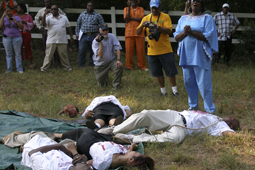A study of a community grappling with a racist past
Reenactors hopes of encouraging witnesses to come forward are unfulfilled
 Photos/Ellen Schattschneider
Photos/Ellen SchattschneiderReenactment of unsolved 1946 racial murders: Anthropologist Auslander is kneeling, with camera, in photo above.
A shameful event haunts residents of rural Walton County, Georgia.
Two young African American couples were brutally murdered by the Ku Klux Klan in the summer of 1946. Two men and two women, one man a recently returned soldier from World War II, were pulled screaming from a car on an isolated bridge, dragged down an embankment and summarily shot. The bodies were riddled with scores of bullets.
The FBI offered a reward, but a veil of silence descended on Walton County, and to this day, no one has ever been arrested, much less convicted. The murders remain unsolved.
In 2005 a group of local people set out to memorialize the murders and attempt to bring the living perpetrators to justice before they all died off. A detailed reenactment was staged with high hopes that the veil of silence would finally be lifted and witnesses would come forward. This reenactment has been repeated every year since, drawing hundreds spectators, but to date there have been no arrests.
Brandeis Assistant Professor of Anthropology Mark Auslander has attended the reenactments through the years, observing as participants struggle with the logistics, the purpose and the effects of the spectacle. The resulting article, “Holding on to Those Who Can’t be Held: Reenacting a Lynching at Moore’s Ford, Georgia,” has just been published in Emory University’s online journal, “Southern Spaces.”
“It’s believed that some of the perpetrators are still walking the streets,” says Auslander. “People want courtroom trials because the dead cannot rest in peace, the community cannot have a productive future, until there is a full accounting of the past. Many people feel there’s been a conspiracy of silence that has protected these killers. It would take a lot of courage for eyewitnesses to come forward.”
No witnesses have stepped up to name names despite the reenactment being staged six times. It has been challenging enough just to find white people in the county or elsewhere in the state each summer to play the roles of the Ku Klux Klansmen. Some years local African-Americans have had to step in, wearing white hoods or white masks. Intense media interest in the initial reenactment has since died down, while tensions have risen among those who plan the event each year.
The situation, says Auslander, has left the people of Walton County in a kind of limbo.
“Now they say that this reenactment doesn’t help reconciliation as long as no one steps forward,” says Auslander. “With no justice there can be no reconciliation. Without prosecution, without enough witnesses, there was no way to move forward.”
Auslander says there has been much soul searching, with people asking, “Do you need prosecution in order to have justice? In South Africa, you could have reconciliation as long as there was truth-telling.”
Auslander’s students have studied the dilemma and have grappled with questions of their own.
“Some say you wouldn’t go to Auschwitz to reenact genocide,” Auslander says his students note. “Others say through the [Jewish Passover] seder you are reenacting freedom from bondage. The question is, what form of memory is appropriate?”
Auslander says that these kinds of questions raised by Brandeis students have a particular resonance as they travel through the deep South.
"A lot of Brandeis students were involved in Freedom Summer in 1964,” says Auslander, speaking of the mass migration of northern college student volunteers, many of them Jewish, who faced grave danger to conduct voter registration drives in the rural South in the summer of 1964. In recent years, “when we were in the Mississippi Delta, we found that local people knew about Brandeis because they associated Brandeis with people who were here in Freedom Summer ’64, perhaps more than people would recognize Brandeis in parts of Boston.”
Auslander wrestles with the reenactment dilemma in his article, which he describes as a “contribution to the difficult dialogue on race and memory.” In it, he writes:
"I have been deeply torn, and seen my friends torn apart, by bitter arguments over the wisdom and impact of the performance. Does it call necessary attention to a long-suppressed crime? Does it encourage witnesses to come forth, bringing evidence that might contribute to successful prosecution of this six-decade-old cold case? Or does it undermine the work of racial healing and reconciliation undertaken by interracial organizations? Does it unintentionally feed cycles of hated and retribution, raising the possibility of new acts of violence even as it polarizes those who ought to be in dialogue?"
“The kind of teaching we do at Brandeis, we go into difficult areas,” says Auslander. “It’s a very Brandeis thing that the Ethics Center will bring together people who are opposed and provide a kind of safe space. We’re interested in conflict resolution and reconciliation. That’s what the piece is for. It’s to help with the difficult dialogue. It’s not to make a recommendation, but to help each side hear what the other side is saying.”
Categories: Humanities and Social Sciences





